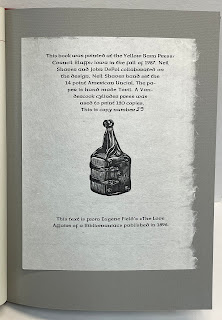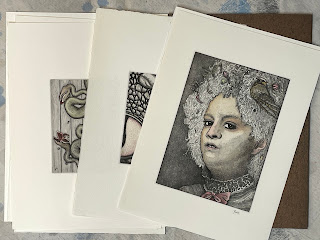Scott is primarily known as the recording artist loscil, and has released more than two dozen albums over the past 25 years (depending how you count LPs, EPs, digital only & etc.), all of which have received heavy rotation at HM. His live shows are accompanied by his original videos, many incorporating photographs or videos he’s shot (see here). The first ones I saw were from his 2014 Sea Island tour. There have been some recurring images and elements in his videos, particularly the inclusion of geometric negative spaces in the screen’s center. Wells’ epilogue ruminates on how terrible events inflicted on earth and humanity might affect the decisions we make for our future; I thought it somewhat apropos. I asked Scott if he might want to contribute one or more original images, and luckily he shared my enthusiasm for the text.
Once the plates were made we assembled at New Leaf to pull some proofs and consider ink variations. Both the text and etchings are printed on Barcham Green’s Royal Watercolour Society handmade paper, the text on a NOT (i.e. slightly rough) sheet, the prints on a hot pressed sheet. Neither is pure white. Some of the proofs were pulled on sheets closer to pure white, and the difference slight variations in a paper’s hue had on the result was significant. This isn’t news but we briefly discussed pulling a few sets of proofs on five or six different white sheets, simply to illustrate how the paper affects the printed image. Sort of like PSNABW but for intaglio.
AND ANOTHER THING!
I’ve always felt slightly baffled by being human—as if this form came too soon, and I should’ve had at least one more round as a gopher, a wren, or maybe a fox. By making work based on animal forms, I’ve found a way to try on their shapes, slip into their skin, follow their instincts, and experience the world through their eyes. These animal-based images let me explore alternate incarnations—and facets of myself otherwise eclipsed by the human experience. In creating these creatures—sometimes real, sometimes imagined—I find a place to remember what it feels like to move through the world with certainty and grit. – Briony Morrow-Cribbs














.%20Metamorphoses%20in%20Italian.%20Le%20trasformationi.%20Translated%20by%20Lodovico%20Dolce%20(1508-1568).%20Venice%20Gabriele%20Giolito%20de'%20Ferrari%201553.%20Christie's.png)


%20Lost%20Time%20Books.png)








%20Amazon.co.uk%20Home%20&%20Kitchen.png)
















